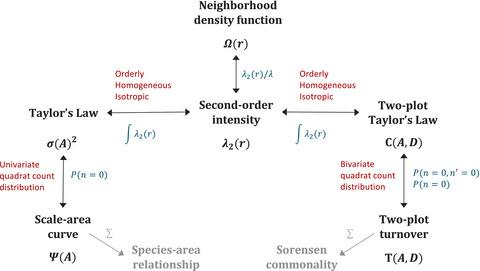当前位置:
X-MOL 学术
›
Ecol. Lett.
›
论文详情
Our official English website, www.x-mol.net, welcomes your
feedback! (Note: you will need to create a separate account there.)
A unified framework for species spatial patterns: Linking the occupancy area curve, Taylor's Law, the neighborhood density function and two-plot species turnover
Ecology Letters ( IF 7.6 ) Pub Date : 2021-08-04 , DOI: 10.1111/ele.13788 Justin Kitzes 1 , Micah Brush 2 , Kyle Walters 1
Ecology Letters ( IF 7.6 ) Pub Date : 2021-08-04 , DOI: 10.1111/ele.13788 Justin Kitzes 1 , Micah Brush 2 , Kyle Walters 1
Affiliation

|
The description of spatial patterns in species distributions is central to research throughout ecology. In this manuscript, we demonstrate that five of the most widely used species-level spatial patterns are not only related, but can in fact be quantitatively derived from each other under minimal assumptions: the occupancy area curve, Taylor's Law, the neighborhood density function, a two-plot variant of Taylor's Law and two-plot single-species turnover. We present an overarching mathematical framework and derivations for several theoretical example cases, along with a simulation study and empirical analysis that applies the framework to data from the Barro Colorado Island tropical forest plot. We discuss how knowledge of this mathematical relationship can support the testing of ecological theory, suggest efficient field sampling schemes, highlight the relative importance of plot area and abundance in driving turnover patterns and lay the groundwork for future unified theories of community-level spatial metrics and multi-patch spatial patterns.
中文翻译:

物种空间格局的统一框架:连接占用面积曲线、泰勒定律、邻域密度函数和两地物种周转
物种分布空间模式的描述是整个生态学研究的核心。在这份手稿中,我们证明了五个最广泛使用的物种级空间模式不仅相关,而且实际上可以在最小假设下从彼此定量推导出:占用面积曲线、泰勒定律、邻域密度函数、泰勒定律的两区变体和两区单物种周转率。我们提出了一个总体数学框架和几个理论示例案例的推导,以及将框架应用于巴罗科罗拉多岛热带森林图的数据的模拟研究和实证分析。我们讨论了这种数学关系的知识如何支持生态理论的测试,提出有效的现场采样方案,
更新日期:2021-09-09
中文翻译:

物种空间格局的统一框架:连接占用面积曲线、泰勒定律、邻域密度函数和两地物种周转
物种分布空间模式的描述是整个生态学研究的核心。在这份手稿中,我们证明了五个最广泛使用的物种级空间模式不仅相关,而且实际上可以在最小假设下从彼此定量推导出:占用面积曲线、泰勒定律、邻域密度函数、泰勒定律的两区变体和两区单物种周转率。我们提出了一个总体数学框架和几个理论示例案例的推导,以及将框架应用于巴罗科罗拉多岛热带森林图的数据的模拟研究和实证分析。我们讨论了这种数学关系的知识如何支持生态理论的测试,提出有效的现场采样方案,











































 京公网安备 11010802027423号
京公网安备 11010802027423号